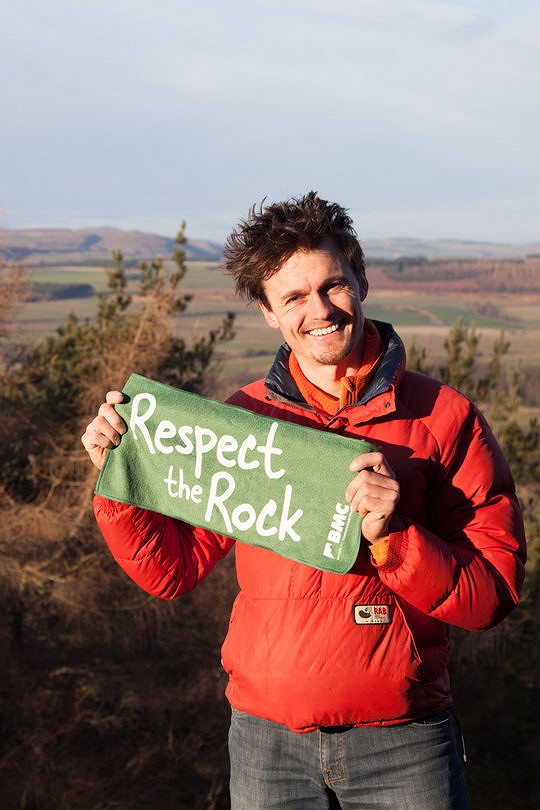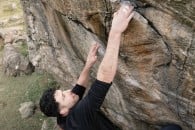
Bouldering is arguably the climbing discipline with the least extensive entry requirements; you may well have heard people say that all you need is a pair of shoes and a piece of carpet. Whilst that may be the case if you're a purist with nerves (and ankles) of steel, for the rest of us there are number of other things that are worth bringing along to help ensure that we have a fun - and safe - day out at the crag, ideally one that will get us psyched for the next day out, rather than sending us back to the wall with our tails between our legs.
Let's start off with the obvious one...
Climbing shoes
Whilst Charles Albert might say otherwise, most of us would be lost without them. It might be tempting to scramble up easy boulders in your muddy trainers, but doing so will cause unnecessary wear to the rock, the cardinal sin of climbing outdoors!
Though choosing the right shoes is crucial when you're pushing your grade, for your first forays into the world of climbing outside, whatever shoes you use indoors are likely to be fine outdoors as well, and will be one less 'new' thing to have to add to the list.
A bar towel/rag
This is an item you definitely don't need down the bouldering wall, but something that is absolutely essential when bouldering outside.
The great outdoors is (almost certainly) less clean than your local wall. Having a rag to wipe grit, grass, dust, and mud off your shoes between attempts will not only mean that the rubber adheres to the rock as well as possible, but that your shoes won't cause unnecessary wear to the rock by being more abrasive than they already are.

Assuming it's clean enough to not make the problem worse, a bar towel can also a great chalk-removal tool - give the hold a quick whip and watch the excess chalk go flying.
A bouldering pad
A pad is one of the more crucial items on the list, protecting you from tweaked ankles, bruised tail bones, and compromised cranial integrity. A good pad set-up can help you climb to the best of your ability, whilst a poor set-up will risk injury and make you feel scared to try moves you're not 100% sure on - in which case, why even bring a pad?
Head down to your local shop/wall and see what they have to offer, try out different shapes and sizes and depths of foam and carry systems, and read some of our reviews to see what we recommend. Pads are expensive, so it's worth seeing if you can rent them from your local wall (possible in many places) if you're just starting out, or asking a friend if you can go with them or borrow a pad when they're not climbing.
If your project needs plenty of pads, then you can always go on forums and see if anyone else is keen to put in some time on the same boulder, or just wait for a clear, crisp day, when the chances are higher that your project will see some interest.
A chalk bag and chalk
You don't have to climb with chalk, but most people would agree that it helps. The key thing is not to over-do it; remember, it's there to keep your fingers dry, not paint the rock! Try to check your fingers before you chalk up to see whether you actually need to. If you do, then go ahead, if you don't, then it saves you from making the boulder chalkier than it needs to be. Check out some tips for responsible chalk use and brushing here:
A brush/toothbrush/back brush
To clean excess chalk off the holds when you arrive at the boulder, during your session, and before you leave again, a brush is essential. Brush gently, and beware of over-brushing, as it can just lead to polished holds on rock-types such as sandstone or gritstone.
Generally speaking, unless you're cleaning up a bullet-hard unclimbed boulder for the very first time, a soft-bristled brush it's all you're likely to need.
Comfy shoes
Climbing shoes can be uncomfortable at the best of times, but on a freezing cold day you'll be even more excited to get out of them between problems. When you are out of them, you want something comfy you can unlace and slip into quickly while your toes regain sensation.
Warm clothing, food, water, and a hot drink
I might just be writing this because my last session outdoors saw me in zero degree weather for six hours, but keeping warm is essential. Having a bulky belay jacket, thick warm gloves, a beanie, and some thick socks to throw on between attempts is a game changer. Moreover, a big jacket gives you somewhere warm to stash your climbing shoes for the walk-in and in between attempts, which your toes will thank you for!
I'm a fan of the 'jacket-and-gloves-off-climb-quickly-and-throw-them-back-on-before-you-get-frostbite' method, but a mid-layer is also a good shout.
As the old adage goes, 'the best climber is the one having the most fun', and nobody is having fun when their ears, fingertips, or toes feel like they might spontaneously explode due to sheer cold.
Similarly, the climber having the most fun is likely the one with a thermos full of tea or coffee and a tasty flapjack ready for when they need a quick energy hit; so pack accordingly!
Skin Care/Nail-Clippers/First-Aid kit
Tape up to prevent the rock from wearing through your fingertips. Bring superglue, for when it inevitably does; and nail clippers, for when you get a gruesome flapper. For anything more serious, you'd be well advised to pack a first aid kit, too.
It's also worth taking a bit of sandpaper to get rid of any small bits of skin hanging off your fingers. Small bits of skin hanging off your fingers have an unfortunate habit of turning into big bits of skin hanging off your fingers.
Tape can also be used to attach a hand-held bouldering brush to a longer stick to make a longer brush; just be sure to take any waste tape with you when you leave the crag.
A guide/App
Of course you can head out, spy a bit of rock that looks good, and do your best to get to the top of it, but Guidebooks and Apps provide a wealth of information to make the whole process much more enjoyable, from pointing you towards the creme-de-la-crag boulders, to providing inspirational photos to get you psyched, to giving you fair warning of additional things you might want to consider in terms of parking, pad set up, or access.
You can check out our own offerings here:
Rockfax guidebooks
Rockfax Digital App
A way to warm up
Crags aren't the best for warming up at. They don't have Beastmakers pre-installed, they don't have resistance bands or yoga mats freely available, and, all too often, they don't have easy climbs to get your joints moving and your body and mind working together.
A portable fingerboard and a resistance band will help solve most of these issues. Use the approach to get your heart rate up and then use the resistance band in all sorts of weird ways to warm up your shoulders, elbows, and - once attached to the portable fingerboard - your fingers.
If you can find some easy ground to spend some time on before pulling onto harder projects, I'd recommend it. If the crag is vaguely near, then I'm a big fan of warming up on a fingerboard at home. This allows you to properly prime your fingers for what they are about to endure, while also giving them a decent rest as you make your way to the crag.
Knowledge of the local rock and restrictions
Not gear, as such, but it's useful information to have.
Knowing a little bit about the local rock will help ensure that you don't climb in a way that could cause you harm or risk damaging the rock itself - i.e. climbing on wet sandstone - whilst knowing about local restrictions will make sure you don't risk interfering with local wildlife.
UKC has plenty of info about these kinds of things, both in the logbooks and in articles - such as the one below from Robbie Phillips - so give the site a search, or ask on the forums if you're unsure of the etiquette.
Phone
The final essential: a phone, to take photos of beautiful rocks, to film your friends climbing their long-time projects or their first outdoors boulder, and, in the worst case scenario, to call Mountain Rescue if something goes wrong.
More Articles

















Comments